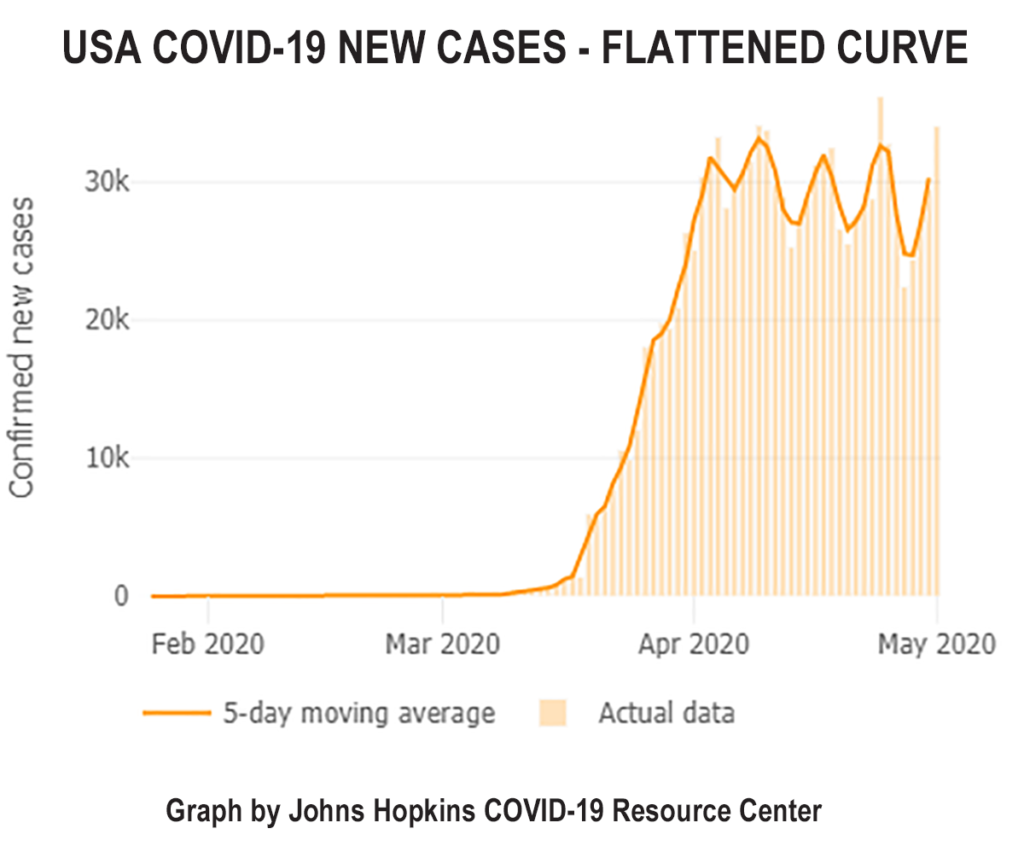California Governor Gavin Newsom announced $2.5 billion funding for COVID-19 smackdown of small businesses in his state.
Category: Health
States that reopened early have not experienced COVID-19 infection spike
There was considerable outcry from COVID-19 lockdown advocates when certain states decided to reopen early. Their argument was that COVID-19 cases would spike, resulting in a large increase in deaths. But the spike in infections of COVID-19 in reopened states did not happen.
The logic of the pessimistic predictions was understandable. If the purpose of the lockdowns was to “flatten the curve” then it was reasonable to assume that removing the lockdowns would “bulge the curve.”
According to a tweet by ABC News lead medical reporter Eric Strauss, ABC reviewed the stats from 21 states that lifted or eased their lockdowns on or before May 4, 2020 and found no spike in infections. Strauss based his statement on research done by fellow ABC reporter Ariel Mitropoulos (Twitter handle @AMitrops).
“JUST IN: [ABC News] looked at 21 states that eased restrictions May 4 or earlier & found no major increase in hospitalizations, deaths or % of people testing positive in any of them. [SC, MT, GA, MS, SD, AR, CO, ID, IA, ND, OK, TN, TX, UT, WY, KS, FL, IN, MO, NE, OH] via @AMitrops,” tweeted Strauss on May 28.

These results imply that perhaps medical professionals still do not fully understand how COVID-19 is spread. If implementing the lockdowns actually worked in reducing the spread of the disease, then lifting the lockdowns should have had the opposite effect. If we aren’t seeing large outbreaks with the easing of restrictions, then people are reasonably asking why we had the lockdowns in the first place.
Regarding the progress being made against the COVID-19 pandemic, Georgia Governor Brian Kemp stated, “We remain encouraged by the numbers that we are seeing in testing, hospitalizations, and a wide variety of other data points from across the state.” Kemp continued, “We are also encouraged by the new treatment being rolled out for patients in Georgia in partnership with the Trump administration. This week, the Department of Public Health will distribute over 18,000 vials of Remdesivir to eighty-five hospitals across the state.” Georgia was one of the first states to start reopening.
Despite the lack of major outbreaks, it hasn’t been a completely smooth reopening everywhere. For example, Texas is currently fighting a surge in infections in the city of Amarillo. “Here in Texas, we have implemented a strategy that enables Texans to get back to work while mitigating further spread of COVID-19,” said Governor Abbott. “Amarillo is an example of this strategy in action, and our surge response teams have done a tremendous job in containing the hot spots within the Amarillo community and protecting health and safety. As we continue in our efforts, we are committed to prioritizing public health while safely and strategically opening the state.”
Many people across America and the world are experiencing considerable anxiety over the prospect of lifting COVID-19 restrictions. Hopefuly this report by ABC News will help reduce some of their stress.
As of the writing of this article, ABC News had not yet published their research.
By Sterling Szymanski. Opinions are my own. To follow me or add me as a friend on the Bigwigg Social Network, please visit my Profile Page.
On Bigwigg there is no shadow-banning or ideological censorship. Join Bigwigg today for free and invite your patriotic friends. ![]()
Nature’s Best Toilet Paper Substitutes
The average American goes through 30 rolls of toilet paper a year, but 70% of the world’s population doesn’t use it at all. So what do they do instead?
As I write this, Charmin, Cottonelle, and Downy Soft toilet paper, to name a few, are “currently unavailable” on Amazon. This verifies what you’ve always suspected: When things get scary in the US, the first thing most of us think about is pooping. The average American goes through 30 rolls of toilet paper a year, which is kind of impressive but still not a reason to stock an entire wall of your basement with them. Seventy percent of the world’s population doesn’t even use bathroom tissue. They use a variety of things, including, in some countries, the left hand. I have no intention of covering that technique here.
People have always devoted a lot of thought to cleaning their backsides.
As early as the 6th century, the Chinese scholar Yan Zhitui wrote that he preferred not to use paper containing quotations from the sages. The first task-specific toilet paper was invented in China in 1391. The sheets were initially intended for the royal family. They were big and perfumed. A 16th century French writer recommended “the neck of a goose that is well downed.” Doesn’t sound like a bad idea. On the other hand, it’s tough stockpiling goose necks.
The Romans pooped communally—just like they did most things—and used a sea sponge attached to a stick to clean themselves.
Between uses, the stick was plunged into sea water. This, incidentally, is where the phrase, “the sh*tty end of the stick” comes from. The Vikings used old sheep wool and smooth pottery shards. They were hardy people. The Eskimos used two of the better toilet paper substitutes: snow in the winter and tundra moss when it was available. Snow, incidentally, is often ranked both as one the best and one of the worst alternatives by natural-bathroom-tissue experts. On the plus side, it is fantastically effective, both smooth for comfort ,and mildly abrasive for effective cleaning. What’s more, it can be custom-shaped. On the minus side, it’s really cold. It’s also wet. A wet butt is not a good thing.
In this country, until the late 1800s, it was common to find a corncob hanging from a string in the outhouse.
I know, I don’t want to think about it either. Seems like it would start out too smooth and end up too rough. And, of course, it was communal. Really, I have no idea why it was so widely used.
The Sears catalog changed everything and was a quantum leap in bathroom technology. It was free, contained hundreds of soft, uncoated pages, and gave you something to read in the meantime. The sort of toilet paper we use today wasn’t commercially available until 1857. Gayett’s Medicated Paper for the Water Closet contained aloe and was marketed as being good for hemorrhoids, which were called “piles” back in the day. The patent for rolled toilet paper was granted in 1891. Fun fact for settling bar bets: The original patent drawing shows the paper unspooling from the top rather than the bottom. This is the only sensible way to do it, but some people like to quibble.
If you find yourself in a survival situation—or if you just can’t buy toilet paper anywhere right now—you’ve got options.
Believe it or not, smooth stones, like river rocks, of a fairly small size are considered one of the better choices for the task. Not particularly absorbent, but they’re better than a corn cob. The cones of Douglas fir trees are recommended because they are said to be comparatively soft. “Comparatively” is the key word here. A handful of grass stalks, all carefully and tightly bundled and then folded over to create a “brush” is another popular alternative on survivalist websites. It actually looks sort of doable.
But if my ass were on the line, I’d reach for one of these six options, at least one of which is available anytime and almost anywhere in the great outdoors.
Moss

The gold standard among natural toilet papers. Think of it as green Charmin. Moss is soft, absorbent, and full of iodine, a natural germ killer. It grows all over the country, and not just on the north side of trees. Don’t be particular about species. For one, it’s extremely difficult to identify. For another, it doesn’t matter. Go for it. Make sure you have more than you think you’ll need. (Note: This should probably go without saying, but the time to go look for wiping material is before you lower your trousers. It’s a lot harder to move around afterward.)
Old man’s beard

There are 87 kinds of old man’s beard, including Spanish Moss (sort of, it’s complicated) and similar lichens. They all grow on trees and look like tangled fishing line (but make much better, softer wiping material). It also contains usnic acid, which is effective against Streptococcus and Staphylococcus bacteria. Dried, it also makes a great fire starter. Win-win.
Lamb’s ear

Another standout. It’s not native but grows throughout the US. The leaves are big, quite soft, and absorbent. They are said to feel like sitting on a cloud, which may be stretching things a bit. Lamb’s ear has natural antibiotic qualities that makes it nice on your backside. It also makes a great alternative to a band-aid if you don’t have any.
Mullein

Similar to Lamb’s ear and found in all 50 states. You just can’t do better than those big, soft, absorbent leaves. It’s also fairly sturdy, which reduces the chance of poking through it. Throughout history, mullein has been used by just about everybody for just about everything. Tribes in the Southwest smoked it to treat mental illness. Eastern tribes used the leaves to treat colds, bronchitis, and asthma. Choctaws used a poultice of its leaves for headaches. Early European settlers used common mullein seeds to paralyze fish. The seeds were also crushed and put into diked areas of slow water. Today, mullein leaves are occasionally used to fashion insoles for weary hikers. You can’t do that with real toilet paper.
Slippery elm

Okay, these leaves are not soft and absorbent. If anything, they’re kind of like sandpaper because the hairs on them contain silica crystals. On the plus side, that is the same property that makes them effective at cleaning. Just be gentle.
Osage orange

It’s said to be one of the best butt wipes ever, but only during a small window of time. The mature fruit is too big to get into the relevant area; what you want is young fruit. The small crevices and bumps on its surface are said to be of the ideal texture for cleaning. You want to make sure to use undamaged fruit, because Osage orange contains a sticky sap that you really don’t want back there.
Finally, a couple words of caution. If you can’t find any of the six above and decide instead to just reach for whatever leaf is handy, give it at least a cursory glance before putting it into action. Most will be fine, but you’ll want to stay away from anything on this list.
Also, wash your hands. I know you are already doing a lot of that lately, but fecal bacteria is a major cause of backcountry nausea, diarrhea, and vomiting. There’s only one right way to do it, assuming you’ve got a companion. After you’re done, have someone squirt some water and some soap into your hands. Your contaminated hands shouldn’t touch anything. Wash thoroughly. Then, you can get back to scouring the internet for toilet paper.
Written by Bill Heavey/Field for Popular Science and legally licensed through the Matcha publisher network. Please direct all licensing questions to legal@getmatcha.com.
Trump’s Fiery Letter to the World Health Organization (WHO)
WASHINGTON, DC – On May 18, 2020, President Trump sent a highly critical letter to the Dr. Tedros Adhanom Ghebreyesus, Director-General of the World Health Organization (WHO) about their handling of the COVID-19 outbreak thus far, particularly regarding their early handling of dissemination of critical information surrounding the initial outbreak in Wuhan, China.
In his letter, Trump claims that WHO’s response to Coronavirus has been filled with one misstep and cover-up after another. The President also points out that American taxpayers send over $400 million to the WHO each year, which is about 10 times what China gives. Despite the much higher funding coming from the United States, the desires of the Chinese government appear to have higher priority than American lives.
“The World Health Organization has repeatedly made claims about the coronavirus that were either grossly inaccurate or misleading,” stated President Trump in the May 18th letter. “You praised the Chinese government for its ‘transparency’ with respect to the coronavirus, announcing that China had set a ‘new standard for outbreak control’ and ‘bought the world time’. You did not mention that China had, by then, silenced or punished several doctors for speaking out about the virus and restricted Chinese institutions from publishing information about it.”
President Trump stopped funding WHO last month, until their mismanagement of the pandemic is investigated. The administration’s stated plan is to redirect US health aid to other groups directly engaged in the fight against COVID-19. Trump has proposed reinstating WHO funding at the same lower level as China contributes.
The full letter from Trump to Tedros is available HERE.
By Sterling Szymanski. Opinions are my own. To follow me or add me as a friend on the Bigwigg Social Network, please visit my Profile Page.
On Bigwigg there is no shadow-banning or ideological censorship. Join Bigwigg today for free and invite your patriotic friends. ![]()
Moving the Goalposts — Four Reasons it is Safe to Open America
By Jonathan Geach, M.D.
This article is reprinted from the Conejo Guardian.
Original Goal: Flatten the Curve
The curve of new infections is declining and we do not need to wait for additional testing or a surveillance apparatus to be in place to reopen America.
In response to warnings that millions of Americans could die, and the carnage COVID-19 created in Italy, state and local governments instituted drastic social distancing in America. In the meantime, the epidemiological curve in the US has followed the trend seen in Europe and is well past its peak.
The Institute for Health Metrics and Evaluation (IHME) model estimates that the peak of deaths in the U.S. occurred on April 13, 2020. This would seem to indicate the time to loosen social distancing and allow a return-to-work has arrived.
Despite this new information, several public health officials have said that May 1 may be too soon to reopen. They claim that we don’t know enough about the virus, and it won’t be safe to reopen America until we have improved testing and surveillance.
Original Goal: Prevent Healthcare System Saturation
The healthcare system is not overwhelmed, it is underwhelmed and being damaged.
The purpose of “Flatten the Curve” was to prevent the healthcare system from being overwhelmed with patients suffering from COVID-19. The reality is that the healthcare system is now underwhelmed and healthcare workers are being laid off and furloughed in droves as a result of healthcare centers having neglected patient care not related to COVID-19 in fear of a COVID-19 surge that failed to materialize on a nationwide basis. This means tens of millions of patients are failing to receive the medical care they need in a timely manner. Almost every hospital outside of the hotspots is empty.

The dramatic reduction in healthcare utilization and capacity is by no means limited to small, country hospitals. Mayo Clinic is empty: 65% of the hospital beds at Mayo Clinic are empty, as are 75% of the operating rooms. This is the world’s premier medical center. If Mayo Clinic is empty, imagine how dire the situation is at smaller, community-based healthcare centers. Given the complexity of the patients referred to Mayo Clinic, its emptiness alone will have a significant negative impact on healthcare outcomes.
Healthcare underutilization leads not only to patient care being delayed, which will likely result in deaths from delayed cancer diagnoses; it also leads to the loss of countless jobs in the healthcare industry, many of which will never return. Even if the patients that are not being seen at this time are seen several months in the future, many will still suffer negative health outcomes. In Medicine, timing is of the essence and diagnosing and treating a patient today is more beneficial than diagnosing and treating the same patient for the same condition in the future.
If the goal of the shutdown was to flatten the curve and prevent healthcare system utilization, why are we still under a shutdown when the healthcare system is significantly underutilized and tens of thousands of healthcare workers are being terminated or furloughed? Why are we still denying non-COVID-19 patients the care they need when hospitals are sitting idle and laying off staff in droves? The only surge we’ve seen thus far is with respect to initial weekly jobless claims; tragically, there’s a good chance we will see a surge in suicides later this year as well.
Original Goal: Determine the true mortality
The evidence that the true mortality is much lower than early estimates continues to mount.
Now, I know many people will say, “But look at New York. Look at how the hospitals were full and we almost ran out of ICU beds and ventilators. COVID-19 is nothing like the flu.” To these objections I must point out that COVID-19 kills people through a prolonged process that generally keeps people in an ICU on a ventilator for two weeks before they die. Most people who die of the flu have a much faster disease process.
A new study in The New England Journal of Medicine supports the claim that COVID-19 is much more common and mild than first believed. Researchers from Columbia University in Manhattan tested every woman who presented in labor for COVID-19 from March 22 until April 4. Fifteen percent of the women tested positive for COVID-19, but, of these, eighty eight percent were totally asymptomatic. Also interesting, none of the women who tested positive were even sick enough to seek COVID-19 care; they simply came to the hospital to have a baby. Eighty-eight percent of positive women were asymptomatic.

The USS Theodore Roosevelt has been in the news for an outbreak aboard the ship. The US Navy is testing every sailor on board. Of the 4,800 sailors, 600 tested positive and 60 percent of those were entirely asymptomatic.
The first prevalence antibody study from Stanford was released on 4/17/20. After sampling the blood from 3,300 people, researchers found that 48,000 to 81,000 people in Santa Clara county had been previously infected. Only 1000 people tested positive in the county.
Many people are actually claiming that the large number of asymptomatic people with the disease requires prolongation of the shutdowns. The large asymptomatic group does quite the opposite. It demonstrates that the number of people who have already had the disease is very high and the actual infection mortality rate is much lower than we previously believed.
Original Goal: Prevent a catastrophic second wave
If there is a second wave, it will most likely be this fall which will give us plenty of time to prepare
The biggest concern voiced by public officials is that opening the economy is unsafe because it could, “Pour gasoline on the fire.” These officials don’t understand that most people who recovered from the infection are now immune and, thus, contribute to the development of “herd immunity.” If the next wave comes, the peak will be lower or, like in South Korea, where social distancing was only voluntary, it may be just a period of a low rate of new cases until herd immunity is build.
If the current level of herd immunity is so low that a second wave builds, it will take at least several months. The CDC estimated that it will likely be at least 150 days before a possible second wave. This would push it back to the fall at the earliest. A study published in The Lancet also states it would be several months before a possible second wave.
Personal protection equipment (PPE), testing, and surveillance may not be optimized today, but all should be in place by this fall. At that time, politicians and scientists can determine how the elderly and vulnerable can be protected without needing to interrupt the economy.
In addition, the shutdowns are slowing if not preventing the development of herd immunity. This increases the chance and possible severity of a second wave of COVID-19 several months after the shutdowns are lifted.
The idea of herd immunity is simple: Once enough people in society are immune to a disease, if one person becomes infected, the chance they give it to someone else is less than one. It is estimated that 80% of the population would need to be immune to have true herd immunity. However, if we have even half that, we would slow the increase of the virus dramatically. This would make surveillance easier and decrease the chance that a second wave could overwhelm our health care system this fall.
In Summary
Continued shutdowns threaten our economy, our health and even our healthcare system.
The state of our economy is not just a monetary risk, it is a health risk. When people lose their jobs, they typically lose their health insurance. The British Journal of Psychiatry found that there were more than 10,000 “economic suicides” as a result of the 2008 recession. Similarly, a 2016 study from The Lancet found that there were an excess 260,000 cancer deaths as a result of the recession. These statistics also fail to mention the increased domestic violence, increased child abuse and home loss when schools and businesses are closed.
In spite of the moving goalposts: The number of new cases is declining. The mortality is likely much lower than early estimates. Those who have been infected by the disease will most likely be immune for at least a year. Finally, the lives saved by starting the economy sooner vastly outnumber those that could be saved by extended shutdowns.
Contributors:
Jonathan Geach, M.D.
Ankur J. Patel, M.D.
Knut M. Wittkowski, PhD, ScD
Lacy Windham, M.D.
Ashkan Attaran, M.D.
Jason Friday, M.D.






